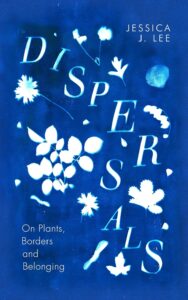Jessica J. Lee’s ‘Dispersals: On Plants, Borders and Belonging’, published this Thursday by Hamish Hamilton, explores the entanglements of the plant and human worlds, the echoes and counterpoints in the migration of plants and people. Emily Hasler reviews, finding the generosity and openness of a packet of seeds saved from one’s own garden.

As I walk home from the Co-op in late February I greet the Alexanders. The glossy deep green leaves are some of the earliest to emerge. Unlike other members of the carrot family every part of this plant is edible, which is presumably why it was introduced, supposedly by the Romans. ‘Pot herb of Alexandria’, ‘Horse parsley’, ‘Smyrnium olusatrum’ (‘myrhh-like black herb’); the salt-loving Mediterranean celery-substitute’s many names are stamps in its passport. And it continues to travel: colonising seawalls, spreading along road verges and finding its way inland — sometimes crowding out other plants. Dispersals, Jessica J. Lee’s fascinating new book, abounds with the entangled tales of plants and humans, examining ‘the stories that constellate around species we’ve encountered through our own migrations around the globe’.
In fourteen diverse and innovative essays, Lee picks apart our ideas about plants, asking where they come from and if they might ‘serve us any longer.’ The collection is cosmopolitan, reaching across the globe and encompassing a wide range of research. Lee’s background is as an environmental historian, but her writing hybridises freely between culture, science, etymology, family history, memory and imagination. This is a very personal collection, because plants colour and flavour our lives. Lee shares her own story of movement, so that for all the brilliant scholarship of her writing it has the generosity and openness of a recipe, or a packet of seeds saved from one’s own garden.
‘Most plants we eat have been shaped by human hands: ancestors, Indigenous people, farmers, plant breeders, and scientists’, writes Lee in ‘Bitter Greens’ which looks at the huge variety of Brassicas. ‘Sweetness’ teaches us that mangoes were one of the first fruits cultivated and have ‘circumnavigated the globe’, while ‘Sour Fruit’ explains how oranges came to be synonymous with Florida though they are not originally from the region. Many of the tales of how plants crossed the world are exciting, featuring enigmatic ‘plant explorers’ such as David Fairchild who became ‘special agent’ and travelled the world to bring an incredible catalogue of food crops to the US. Or Robert Fortune, a Scottish botanist sent by the East India Company to China, disguised in Mandarin dress, to acquire both tea plants and the knowledge to cultivate them. But Lee is wary of the easy narrative of adventure, reminding us of the importance of ‘decolonising our cultural narratives’. She invokes the idea of the ‘Plantationocene, the systems of cultivation, global transport, enslavement, plant transfers and power that characterise our era’ and shows how alternative stories about plants ‘might teach us something of the uneven power in this world.’ There is no mistaken objectivity here. We must ‘take this history personally’ because ‘the workings of empire are not wholly in the past and cannot entirely be undone […] Knowledges and histories shift depending on who’s doing the storytelling.’
For Lee, the stories of plants can ‘teach us to soften the hard borders of our human worlds’: ‘Being weeds, they unpick scientific paradigms, politics, and nationalisms. All the things that ask for circumstances, species, and people to stay in place.’ She makes us question why some plants are deemed to ‘belong’ while others are not? Why are Hollyhocks good and Giant hogweed bad, when both were brought to the UK to adorn gardens? How do we avoid the co-option of ecology into nationalist and racist rhetoric? While recognising the very real problem of biodiversity loss and habitat destruction, Lee questions the labels we use unthinkingly, critiquing ‘the non-neutrality of the language it employs — and to argue that language matters.’ She also asks ‘where and when, exactly, we might locate a version of nature to which we would like to return. At what point do we acknowledge that the environmental legacies of the great acceleration cannot be treated distinctly from the social, cultural, very human power dynamics that shaped them?’ The BSBI’s Plant Atlas 2020 demonstrates that introduced species outnumber native ones across Britain and Ireland (1,753 to 1,692), so ‘How then can we dwell in a zone of imperfection — managing some species while accepting others, in language that does the same’?
I learned a huge amount from this book, but it doesn’t seek to offer simple answers. Lee is unafraid to be imperfect and inconclusive, to doubt, interrogate, to live with uncertainty, and to live with it joyously. There is pleasure here, in the sensory delights of flowers and food, in the family, friendship and community that plants highlight. And there is hope: ‘Saving seeds is an act of belief in a future that the present tells me cannot exist, but I do it anyway.’ These essays, these nuanced and compelling stories, are also an act of belief, that plants ‘in dispersal, might teach us what it means to live in the wake of change.’
*
‘Dispersals’ is published this week. Buy a copy here (£16.14).
Emily Hasler’s latest collection of poems ‘Local Interest‘ (Pavilion Poetry) is longlisted for the RSL’s Ondaatje Prize.